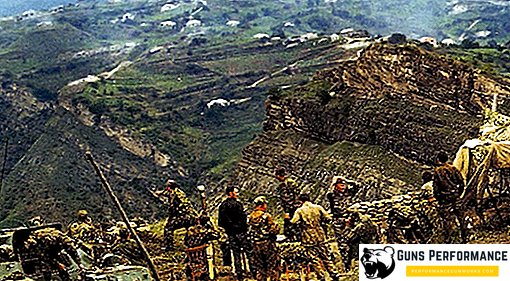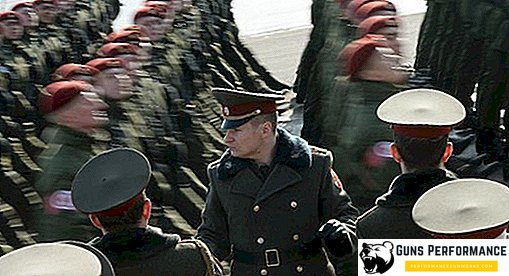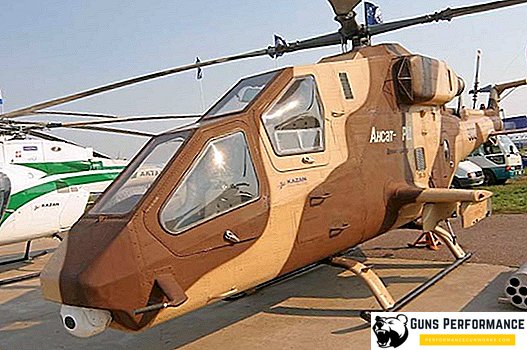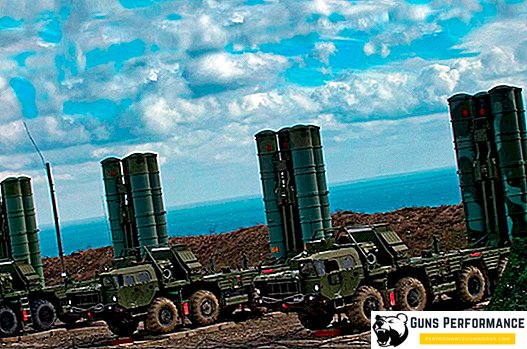
The first time the laser was demonstrated to the general public in 1960, and almost immediately, journalists called it the "ray of death." Since then, the development of laser weapons does not stop for a minute: more than half a century they were engaged in the scientists of the USSR and the USA. Even after the end of the Cold War, the Americans did not close their projects of combat lasers, despite the huge sums spent. And all would be fine - if these billions in investments yielded tangible results. However, to this day, laser weapons remain an exotic show rather than an effective means of destruction.
At the same time, some experts believe that "bringing the laser technology to mind" will cause a real revolution in military affairs. It is unlikely that infantrymen will immediately receive laser swords or blasters - but this will be a real breakthrough, for example, in missile defense. However, such a new weapon will not appear soon.

Nevertheless, the development continues. Most actively they go to the USA. Scientists are fighting over the development of the "rays of death" and in our country, the laser weapons of Russia are created on the basis of the developments made back in the Soviet period. Lasers are interested in China, Israel and India. Germany, Great Britain and Japan participate in this race.
But before we talk about the advantages and disadvantages of a laser weapon, you should go into the substance of the question and understand what physical principles lasers work on.
What is the "ray of death"?
Laser weapons are a type of offensive and defensive weapons that use a laser beam as a striking element. Today, the word "laser" has firmly come into use, but few know that this is actually an abbreviation, the initial letters from the phrase Light Amplification by Stimulated Emission Radiation. Scientists call a laser an optical quantum generator capable of converting various types of energy (electrical, light, chemical, thermal) into a narrow beam of coherent, monochromatic radiation.
Albert Einstein, the greatest physicist of the twentieth century, was among the first to study the theory of lasers. Experimental confirmation of the possibility of obtaining laser radiation were obtained in the late 1920s.
A laser consists of an active (or working) medium, which can be a gas, a solid or a liquid, a powerful source of energy and a resonator, usually a system of mirrors.

To our time, lasers have found application in various fields of science and technology. The life of a modern person is literally filled with lasers, although he does not always guess about it. Pointers and barcode readers in stores, compact disc players and precise distance gauges, holography - all we have is thanks to this amazing invention called “laser.” In addition, lasers are widely used in industry (for cutting, soldering, engraving), medicine (surgery, cosmetology), navigation, in metrology and in the creation of ultra-precise measuring equipment.
Used laser and in military affairs. However, its application mainly comes down to various systems of location, weapon guidance and navigation, as well as laser communication. There were attempts (in the USSR and the USA) to create a blinding laser weapon that would disable enemy optics and aiming systems. But the real "death rays" military still have not received. Too technically difficult was the task of creating a laser of such power that could shoot down enemy aircraft and burn tanks. Only now technological progress has reached the level at which laser weapons systems are becoming a reality.
Advantages and disadvantages

Despite all the difficulties associated with the development of laser weapons, work in this direction continues very actively, all over the world billions of dollars are spent on them annually. What are the advantages of combat lasers compared to traditional weapons systems?
Here are the main ones:
- High speed and accuracy of destruction. The beam moves at the speed of light and reaches the target almost instantly. Its destruction occurs in seconds, to transfer the fire to another target requires a minimum of time. The radiation affects exactly the area to which it was directed, without affecting the surrounding objects.
- The laser beam is capable of intercepting maneuvering targets, which distinguishes it from the anti-missile and anti-aircraft missiles. Its speed is such that it is almost impossible to deviate from it.
- The laser can be used not only to destroy, but also to blind the target, as well as its detection. By adjusting the power, the target can be impacted in a very wide range: from warning to critical damage.
- The laser beam has no mass, so when firing, you do not need to make ballistic corrections, take into account the direction and strength of the wind.
- There is no return.
- The shot from the laser machine is not accompanied by such unmasking factors as smoke, fire or a strong sound.
- Laser ammunition is determined only by the power source power. While the laser is connected to it, its “cartridges” will never run out. Relatively low cost per shot.
However, lasers have serious drawbacks, which are the reason why so far they are not armed with any army:
- Scattering Due to refraction, the laser beam expands in the atmosphere and loses focus. At a distance of 250 km the spot of the laser beam has a diameter of 0.3-0.5 m, which, accordingly, sharply reduces its temperature, making the laser harmless for the target. Even worse, the beam is affected by smoke, rain or fog. For this reason, the creation of long-range lasers is not yet possible.
- The inability to conduct over the horizon. The laser beam is a perfectly straight line; they can only be fired at a visible target.
- Evaporation of the target metal obscures it and makes the laser less efficient.
- High energy consumption. As mentioned above, the efficiency of laser systems is small, so to create weapons that can hit the target, you need a lot of energy. This disadvantage can be called key. Only in recent years has the opportunity to create laser systems of more or less acceptable size and power.
- It is easy to protect from the laser. With a laser beam it is quite simple to cope with the help of a mirror surface. Any mirror reflects it, regardless of the power level.

Combat lasers: history and prospects
Work on the creation of combat lasers in the USSR continued since the early 60s. Most of the military was interested in the use of lasers as a means of anti-missile and air defense. The most famous Soviet projects in this area were the programs "Terra" and "Omega". Tests of Soviet combat lasers were conducted at the Sary-Shagan test site in Kazakhstan. The projects were led by Academicians Basov and Prokhorov, the Nobel Prize winners for their work in the field of laser radiation.
After the collapse of the USSR, work at the Sary-Shagan proving ground was stopped.
A curious case occurred in 1984. The laser locator - it was part of the Terra - was irradiated by the American shuttle Challenger, which led to disruptions in communication and malfunction of other equipment of the ship. The crew members felt a sudden indisposition. The Americans quickly realized that the cause of the problems on board the shuttle was some kind of electromagnetic influence from the territory of the Soviet Union, and protested. This fact can be called the only practical use of the laser throughout the Cold War.
In general, it should be noted that the installation locator acted very successfully, which is not the case with the combat laser, which was supposed to shoot down enemy warheads. The problem was the lack of power. They could not solve this problem. Nothing happened with another program - Omega. In 1982, the installation was able to knock down a radio-controlled target, but in general, in terms of efficiency and cost, it significantly lost to conventional anti-aircraft missiles.

In the USSR, hand-made laser weapons for astronauts were developed, laser guns and carbines lay in warehouses until the mid-1990s. But in practice, this non-lethal weapon was never used.
With the new power, the development of Soviet laser weapons began after the Americans announced the deployment of the Strategic Defense Initiative (SDI) program. Its goal was to create a layered missile defense system that would be able to destroy Soviet nuclear warheads at various stages of their flight. One of the main tools for the destruction of ballistic missiles and nuclear units was to be lasers placed in near-earth orbit.

The Soviet Union was simply obliged to respond to this challenge. And on May 15, 1987, the first launch of the super-heavy rocket “Energia” took place, which was to put into orbit the Skif combat laser station, designed to destroy the American guidance satellites included in the missile defense system. It was intended to shoot them down with a gas-dynamic laser. However, immediately after separation from the "Energy", "Skiff" lost its orientation and fell in the Pacific Ocean.

There were in the USSR and other development programs for combat laser systems. One of them is the self-propelled complex “Compression”, which was worked on at the NGO “Astrophysics”. His task was not burning through the armor of the enemy tanks, but disabling the optical-electronic systems of enemy equipment. In 1983, on the basis of the Shilka self-propelled unit, another laser complex, the Sanguin, was developed, which was intended to destroy the optical systems of helicopters. It should be noted that the USSR was at least as good as the USA in the “laser” race.

Of the American projects, the most famous is the YAL-1A laser, housed on a Boeing-747-400F aircraft. The implementation of this program involved the company Boeing. The main objective of the system is to destroy enemy ballistic missiles in the area of their active trajectory. The laser was successfully tested, but its practical application is a big question. The fact is that the maximum range of "shooting" YAL-1A is only 200 km (according to other sources - 250). Boeing-747 simply can not fly up to such a distance, if the enemy has at least a minimum air defense system.

It should be noted that the US laser weapons are created by several large companies, each of which already has something to boast.
In 2013, Americans tested the 10 kW HEL MD laser system. With its help, managed to shoot down several mortar bombs and a drone. In 2018, it is planned to test the installation of HEL MD with a power of 50 kilowatts, and by 2020 a 100-kilowatt installation should appear.

Another country that is actively developing anti-missile lasers is Israel. The Qassam-type missiles used by Palestinian terrorists are a perennial "headache" of this Israelis. Shooting down Qassam with anti-missile systems is very expensive, so the laser looks like a very good alternative. Development of a laser missile defense system began in the late 90s, the American company Northrop Grumman and Israeli specialists worked together on it. However, this system has not been put into service, Israel has withdrawn from this program. The Americans used the accumulated experience to create a more advanced Skyguard laser missile defense, the tests of which began in 2008.

The basis of both systems - Nautilus and Skyguard - was a 1 mW chemical THEL laser. Americans call Skyguard a breakthrough in the field of laser weapons.
Great interest in laser weapons show the US Navy. According to the American admirals, lasers can be used as an effective element of the ship's missile defense and air defense systems. In addition, the power of the power plants of combat ships can completely make the "rays of death" truly deadly. Of the latest American developments, mention should be made of the MLD laser system, developed by Northrop Grumman.
In 2011, the development of a new TLS defense system began, which, in addition to the laser, should also include a rapid-fire gun. The project involved the company Boeing and BAE Systems. According to the developers, this system should hit cruise missiles, helicopters, airplanes and surface targets at distances of up to 5 km.
Now they are developing new laser weapons systems in Europe (Germany, UK), in China and in the Russian Federation.

Currently, the likelihood of creating a long-range laser for the destruction of strategic missiles (warheads) or combat aircraft at long distances looks minimal. It is quite another tactical level.
In 2012, Lockheed Martin presented to the general public a rather compact ADAM air defense system, which performs the destruction of targets using a laser beam. He is able to destroy targets (shells, rockets, mines, UAVs) at distances of up to 5 km. In 2018, the leadership of this company announced the creation of a new generation of tactical lasers with a capacity of 60 kW or more.
The German arms company Rheinmetall promises to enter the market with a new high-power tactical laser High Energy Laser (HEL) in 2018. Earlier it was stated that a wheeled vehicle, wheeled armored personnel carrier and tracked armored personnel carrier M113 are considered as the base for this laser.
In 2018, the United States announced the creation of the GBAD OTM tactical combat laser, whose main task is to protect against enemy reconnaissance and attack UAVs. Currently this complex is being tested.
In 2014, the presentation of the Israeli Iron Beam Combat Laser Complex was held at the arms exhibition in Singapore. It is designed to hit shells, rockets and mines at short distances (up to 2 km). The complex includes two solid-state laser systems, a radar and a remote control.

The development of laser weapons are conducted in Russia, but most of the information about these works is classified. Last year, Russian Deputy Defense Minister Biryukov announced the adoption of laser systems. According to him, they can be installed on ground vehicles, combat aircraft and ships. However, what kind of weapon the general had in mind is not entirely clear. It is known that tests of the airborne laser complex, which will be installed on the Il-76 transport aircraft, are currently ongoing. They were engaged in similar developments in the USSR; such a laser system can be used to disable the electronic "stuffing" of satellites and airplanes.
With a great deal of confidence we can say that in the coming years, tactical laser weapons will be put into service. Experts believe that lasers will begin to massively enter the army at the beginning of the next decade. The company Lockheed Martin has already announced its plans to install laser guns on the newest F-35 fighter. The US Navy has repeatedly stated the need to place laser weapons on the Gerald R. Ford aircraft carrier and class Zumwalt destroyers.












